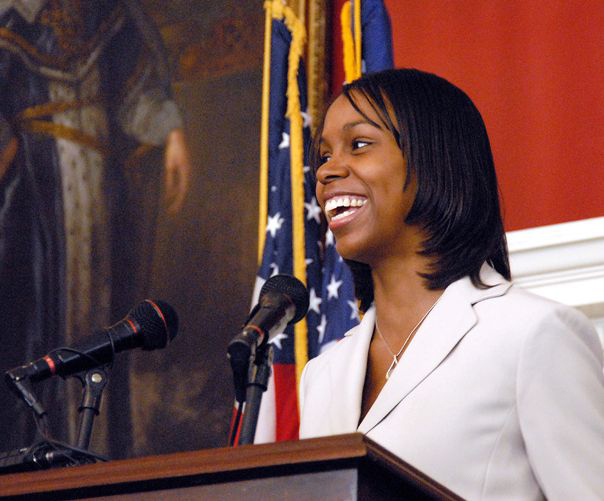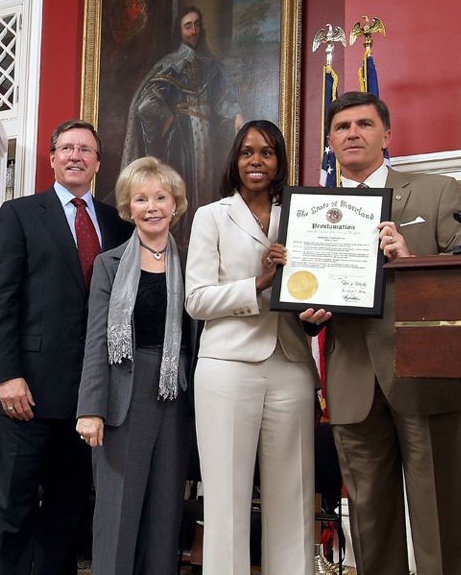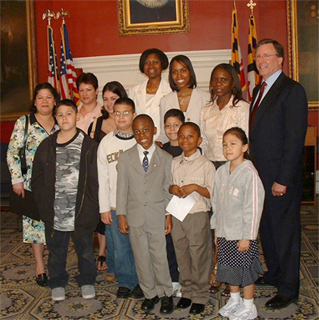
Good afternoon.
(Audience: mumbled "good afternoon.")
I know we're in the Senate building, but I'm a Kindergarten teacher so, good afternoon!
(Audience: "Good afternoon!")
It's a pleasure to be here today, to serve as the keynote speaker because early childhood education really is my passion. There is nothing else better in the world than teaching five-year old children to learn how to read, to write, to do mathematics and to just be curious and wonder about the world. I also believe that early childhood is a critical time in a child's life and it influences what they'll do in the rest of their life.
I know that I decided to become a teacher because I was influenced by my day care teacher. I had a relationship with her and I admired and respected her so much that I decided I wanted to be just like her one day, and I knew that I had to be a teacher. It's funny because I was so excited about learning at such an early age and when I went to Kindergarten I just knew I could to take on the world. All because of my day care teacher Mrs.Chandler.
When I got to Kindergarten though, after about a few weeks of school, I came home and I declared to my mom that I was failing Kindergarten. My mom assured me that I could not be failing Kindergarten and she checked with my father (aside) "you can't really fail Kindergarten can you?" He assured her that I couldn't fail Kindergarten. She assured me that I was doing well and that I needed to go back and continue on in the Kindergarten process.
Well I came home a couple of days in a row saying the same thing, "I'm failing Kindergarten and I just don't want to go back anymore." My mom decided that she needed to go to the school and set up a parent teacher conference to see what was going on, why didn't I feel like I was doing well in Kindergarten? She saw my teacher and my teacher assured her that I was doing very well in Kindergarten. She showed her the gradebook and I had smiley faces all across, no problems. My mom came home and she shared the good news with me that I was not failing Kindergarten, "your teacher says that you are doing very well." I asked her, "if I'm not failing Kindergarten, how come I don't get any stars or stickers on my papers?" "How come none of my papers are hanging up in the classroom?" My mom didn't have an answer. She did go back to the school, and what she noticed was that my classmates pictures and papers were on display hanging in the classroom, and had stars and stickers galore, and my papers were nowhere to be found.
At that point in time I didn't really understand what was going on, as an adult, as an educator, now I look back and think that I had my first encounter with discrimination at the tender age of five. What's more important is that at just five years old, I was concerned about and I was in tune with equity. Equity is an issue that influences my teaching tremendously today. It is an issue that is still so critical in education, that our nation is shining a spotlight on the educational achievement gap that exists in most of our educational systems. We recognize that there is great disparity in the academic achievement of students of color, students from low-income homes and that of their white middle class peers, but yet we believe that education is supposed to be the great equalizer. But when we don't provide an excellent education to every student we do a disservice not only to that individual student, but to our entire society.
This is the greatest social injustice confronting us today. It is one of the reasons why we're gathered here today, to ask the question how can we make No Child Left Behind a guarantee? How will we make sure that every child reaches a standard? How will we address equity?

I have the privilege to teach at Broad Acres elementary school located about 10 miles from here in Silver Spring, Maryland. Broad Acres is a pre-K through five school and it is a school where 90 percent of our students qualify for free and reduced price lunch, about 75 percent of our students speak English as a second language, and we have about a 30 percent mobility rate. Meaning that about 15 percent of our student population leaves the school each year, and a new 15 percent replaces them. It is a school that by all means would be considered a high-need school, a challenging school to work at. It is a school that in the year 2000 was on the brink of academic disaster, we were suffering from low student achievement and declining test scores. In the year 2000, our third graders in our state assessment we had 13 percent students proficient in reading, 5 percent students proficient in math, only 5 percent.
At that point in time we realized that we were doing our students a disservice and we decided "what is it that we can do to make change?" "How can we address equity for our students and give them the opportunity to learn?" We realized that we needed to start with high expectations. We needed to set a standard for students and hold each and every one of them accountable. We had to believe that all students were capable of learning and achieving at high levels. That given the appropriate time and the appropriate resources and then knowing that as educators we had to give them that time and give them those resources.
In addition to high expectations, we needed to teach our students their role in the educational process. We started to teach our students about effort. And let them know that even though all of your teachers have high expectations for you, that you have a role in your own journey. You have to put forth effort, you have to work hard in order to achieve your goals. Working hard is really what makes you smarter. Now, as a Kindergarten teacher giving this message to my students I didn't really know if it was successful. In fact, the students would kind of give me that look, "Okay, Ms. Oliver."
Then one day I realized that they really did understand. I was working on a diversity block in the classroom and one of my students, Douglas, had decided to work on a new alphabet puzzle in our classroom. It was a big deal for my students, who would be the first person to complete this puzzle? And Douglas set out to work on this puzzle all by himself and I noticed as I was finishing up my paperwork that standing waiting patiently for me was Douglas. I said, "What can I do for you, Douglas?" and he took my hand and dragged me all the way across the room to where he had finished the puzzle and he said to me, "Look. Look what I did Ms. Oliver." At that time we had about 5 or 6 students gathered around to see what I would say about what Douglas had done. I said, "Douglas, you worked so hard on that, you completed that puzzle all by yourself, you must have put a lot of effort into that." Douglas looked at me and he put his hands on his hips and he said, "Yeah, that makes me smart, right?"
Effort is a message that even our youngest learners can understand. I think about the possibilities that are available to Douglas with that attitude, towards working hard, towards putting more effort, towards getting smarter and smarter each and every day. We realize that in addition to expectations, in addition to effort, that we had to give our students an early start.
Being a Kindergarten teacher, I realize that many of our children come to school unprepared to learn. They lack so many of the skills that are necessary to be successful in school. The achievement gap, as a teacher, is real. It's not just a phrase or a statistic that you hear about. The achievement gap has a face and a name. Too many faces, too many names, and it walks into my classroom each and every year. One of my many achievement gaps last year was named Katherine. Katherine came to Kindergarten in August, and she was excited to take on the world. She was happy to finally be in school, but she lacked the skills necessary.
Now I'll give you an idea of what I'm talking about. At the beginning of the school year, we like to make our students feel good about themselves, we like to do activities that they are familiar with that we'll build our future learning upon. So in Kindergarten we sing the ABC song, because everyone knows the ABC song, right? Katherine did not know the ABC song. No one had ever taken the time to sing it with her. I'll have my children walk around the classroom and find their names on objects, such as their cubby and their chair. Katherine had a difficult time locating her cubby, locating her chair, because she couldn't recognize her very own name. I have my students draw a picture of their family and tell a story to their classmates about their family members. She had difficulty holding a pencil and a crayon appropriately, and had very limited English skills and couldn't communicate effectively with her peers. After about a week at school, Katherine's self-esteem faded. When I would ask her to perform a task she would push it away and say "No, you do it Ms. Oliver." When I thought about what this meant, that Katherine, on the very first day of Kindergarten, was already being left behind.

With that in mind, it is important that we give all of our children an early start. We know that children who fall behind in the early years are more likely to continue to fall behind. All the research that we've done in Montgomery County shows that if children aren't on target by the end of 2nd grade, that the chances of them catching up are slim. So it is important that we build a strong foundation for our students, that we all be advocates for universal pre-K, for full-day Kindergarten programs, for academic curriculums for our students. Because we know they are capable of achieving much more than we ever expected of them in the past.
We have to build strong foundations for them. I use the analogy of a house, if you build a house on a shaky foundation and if you continue to build on top of it, inevitably it is going to collapse. We need our children to have a solid start, and the only way that start is going to count is if our children have excellent educators in every classroom. I'm happy to say that Katherine was able to complete Kindergarten last year on target, on grade level, and is in first grade this year doing well. But that's only because of the support that I had as a teacher and the other teachers in my class, who helped to meet her individual needs.
So there really is nothing else more important than putting an excellent teacher in the classroom. The quality of a child's teacher is the single most influential factor in determining his or her academic success. So I encourage you today, when you consider that question, "how will we address equity? How will we bridge that achievement gap?" Know that we need to give our students an early start. We need to give them excellent educators who will have expectations for them and will encourage them to put forth their best effort. We need to give our children an early start that will build their academic careers and their lives as well.
Thank you.


